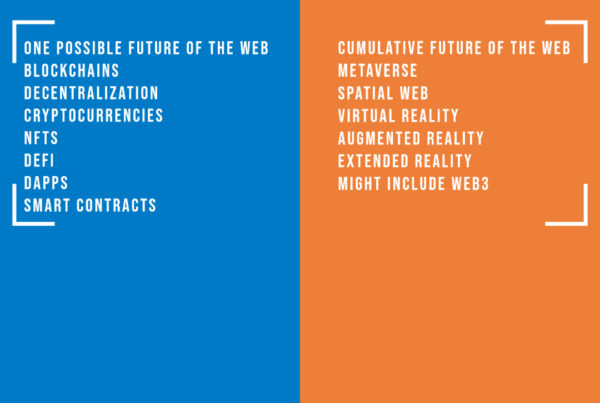Have you ever noticed that people have a tendency to automatically react negatively to something new that they don’t understand?
It seems that we have an intrinsic need to criticize anything nascent without taking the time to understand it. Open-mindedness isn’t as highly valued as many people claim.
This sentiment plagued the internet when it first gained mainstream appeal. Then social media, and smart phones after that.
However, the same people who originally criticized each use all three these days.
And now, it’s the metaverse’s turn.
I’ve spent an inordinate amount of time dispelling rumors and misunderstandings about the metaverse with its advantages. So, I decided to write a blog post about it.
Metaverse Benefits
Here, we’ll discuss the real ways that the metaverse benefits its users and society. We’ll also look at some of the opportunities it currently offers and is expected to eventually offer. Along the way, we’ll cover a few examples that show broader categorical appeal.
Social Contexts
Some of the metaverse benefits discussed here have been around for years – even aside from the metaverse.
However, the new platform will ultimately facilitate collaboration and socializing among users. And, it will allow more creators to get involved and contribute with their own unique offerings, contributions, and content.
Compare this to the early days of the internet. Back then, websites were largely only published by tech enthusiasts and big corporations. Now, anyone can create a website, blog, social media page, or YouTube channel.
In a similar manner, while many of the concepts discussed here have been limited to developers and corporations with specific uses, the metaverse will allow any to contribute. In fact, we’re already in the early days of this happening.
Benefits of Metaverse in Education
Louisiana State University believes that V/R is a more effective educational channel than traditional education.
According to their website, “The way students learn hasn’t evolved much throughout the course of history. Fact retention teaching has long been the traditional approach to education. Studying for tests, sitting in lectures, and trying to visualize history through a textbook constitute the typical classroom experience. However, the introduction of VR has made it possible for students to experience their education in more immersive and engaging ways.”
It makes sense. For example, imagine teleporting medschool students into the human shoulder, where they can watch the bones, ligaments, muscles, and so on work together. This is far more effective than teaching abstract lessons from textbook pictures. That same simulation can also label various parts of the body and explain why they work together the way they do.
Now, apply that to other lessons that are generally abstract. And, consider how it can also impact corporate training.
This is already happening at Walmart. They offer V/R training sessions for new employees with plenty of use-cases to back up the practice.
But it’s not just for students or new employees. It can also help users develop new skills.
For example, I love rock climbing. However, when I first learned how to clean a route, it was nerve-wracking. Yes, I practiced on the ground first so that I could understand the concepts and motions.
But when you’re dangling 100 feet in the air from two small anchors, your mind goes to a different place. I found it harder to focus as I feared that any small mistake could have grave consequences.
The metaverse would’ve been a significant help in this. V/R could still offer the cognitive alertness of hanging high above the ground without actually putting me in danger. It can motivate users with the safer consequence of starting over if they fall (after simulating a long fall), and rewarding them with, perhaps, an NFT for succeeding.
Even better, a virtual climbing program could show where the user went wrong and how to correct their mistakes. And that’s just one of many examples of how the metaverse can help teach otherwise dangerous tasks.
New Experiences for People With Disabilities
The metaverse offers exciting opportunities for people who can’t enjoy the things that most of us take for granted.
For example, in the metaverse, lifelong quadriplegics can finally experience the thrills of hiking and skiing with their friends. So can those suffering from paralysis or a host of other conditions. This, in fact, is already happening.
YouTube VR features 3D videos from adventurers across the globe sharing their most unforgettable experiences. Platforms like Horizon Worlds and Multiverse on Oculus allow users to build their own experiences and share them with others.
We also previously covered the opening of Ellingson National Forest in Second Life. It features lush forests, raging waterfalls, and fun picnic areas that can all be enjoyed without ever so much as standing up.
Mental Health Awareness and Care
Agoraphobics face unique challenges when seeking the mental health care they need. Isolation is usually terrible for mental health, but it’s hard to build a social life when you can’t leave home. Compound that with the additional cost of in-home therapy can build a social life while getting more interactive help for their condition. In fact, as we mentioned in the Ellingson piece, virtual reality is already helping agoraphobics.
The metaverse allows those stuck at home – whether by a mental or physical disability – meet friends and enjoy new experiences together. As we’ve previously mentioned, it’s usually easier to build friendships in the metaverse, even for the socially awkward.
Even beyond agoraphobia, researchers at The University of Barcelona have shown that virtual reality is more effective at helping patients improve mental health. Their research builds on the notion that it’s easier to help those around us than it is to help ourselves.
Virtual reality allows patients to view themselves externally more concretely, according to UB. This allows them to better understand their challenges and comfort themselves.
They can also connect with doctors and others in a more immersive environment without the costs of in-home care. The Multiverse Oculus app does a great job of this with its Mental Health District.
Science, Engineering, and Research
Engineers, scientists, and researchers already use computer models and simulations to run numbers and conduct experiments. This has actually been happening for years. The metaverse can take this to a whole new level.
Scientists and researchers from around the world can collaborate in virtual environments designed to mimic real-world physics to crunch numbers, run models, and test experiments virtually. This is especially useful when real-world experiments would prove to be prohibitively expensive or dangerous.
Of course, these experiments will eventually still need to be conducted in the real world. However, virtual environments can help discover risks and reduce costs. So, by the time a live experiment is conducted, participants will have a better idea of what to expect.
Metaverse Benefits for Consumers
Online shopping has been huge for decades, but it still suffers from one obvious problem: products can’t be tested in the real world until after they’ve arrived.
However, augmented reality (considered part of the metaverse) is changing this.
Consumers can use A/R to see how a piece of decor will appear in their home without it being physically present. Just aim your phone’s camera, move the product into the right position, and see how it looks in real time.
Walmart has recently taken this a step further by allowing customers to try on clothes with augmented reality. It even mimics the movements of different fabrics to see how various fits would look on each person – all before any purchases are made.
New Opportunities for Indie Artists
When social media first gained appeal, artists that had been ignored by the mainstream quickly used it to build their audience. Some found massive fan bases, often rivaling their mainstream counterparts.
These artists included painters, musicians, graphic designers, performers, writers, and even fashion designers, among many others. However, so many people have tried to mimic those early successes that social media is now saturated with fledgling artists.
However, clever artists are finding new opportunities in the metaverse. This has been especially beneficial for musicians (this is already happening).
However, artists and fashion designers are also finding success selling their work as NFTs and in the metaverse (or using the metaverse to promote their work). Even architects can build cities and structures in the metaverse. And, it goes without saying that 3D modelers are finding plenty of opportunities.
But there’s more to it than that. Platforms like Second Life, Decentraland, and Roblox allow users to build experiences for others. These experiences often need writers and designers to create intrigue.
Metaverse Benefits for Business
Virtual work spaces allow coworkers to work and collaborate together in real-time without the expense and environmental impact of building and maintaining an office (this is also already happening). As an added bonus, virtual spaces allow users to build their ideal workspace – such as having several floating monitors perfectly positioned – without the additional expense of actually building that office.
Externally, the metaverse offers more immersive experiences than nearly any other marketing channel – especially when it comes to digital marketing. Each experience can be completely customized and showcase products in whatever manner the business chooses.
Accessibility
The metaverse is easier to access than most people realize. You only need a desktop, smartphone app, or V/R headset. In other words, most people already have what they need.
Once you have a device, it’s just a matter of choosing a suitable platform. We’ve previously covered the best metaverse navigator apps for iOS. If you have a desktop, you can choose pretty much any platform, including Second Life, Decentraland, Meta Ruffy, The Sandbox, or one of other dozens that pop up regularly. Once we have a true metaverse, you’ll likely find it just as easy to access (if not more so).
Early Adoption
You may have noticed that I mentioned “this is already happening” several times. That’s because we’re not just discussing what the metaverse can do, but what it’s already doing. Even in its current hodgepodge, the metaverse is already providing (or capable of providing) the benefits discussed here. Imagine how much more capable it will become once the technology catches up.
Even so, we don’t have to look to the future to metaverse benefits. They’re already happening. However, its recognition has only recently begun to spread beyond enthusiasts. So, now is the best time to get involved as an early adopter. Compare it to being one of the early users of YouTube and TikTok. The audience is growing, but there still isn’t much competition…yet.
Metaverse Disadvantages
For all of the benefits offered by the metaverse, it certainly has its disadvantages as well. Here’s a quick look at each.
Digital Addiction
From people spending hours in front of their TVs to people spending hours on their phones, tech addictions have been around for decades – long before the Internet.
Naturally, the ability to build your own world, connect only with people who most closely match your preferences, and explore places that could never exist in reality have the potential to become addictive. The metaverse does all of this and more.
It really can be an escape from reality, and if we’re not careful, it can overcrowd our reality.
Limited Technology
The physical infrastructure that makes the internet possible is much more limiting than most people realize. It wasn’t exactly designed for persistent virtual worlds.
As we’ve said before, this is one of the many reasons why metaverse graphics are so bad. It’s also one of the reasons why lobbies are so common in online games and virtual worlds; current physical infrastructure can only handle a limited number of participants using CG characters.
Nascent and Unknown
Metaverse platforms are relatively new, and no one really knows what the implications will actually be. Again, this is what we saw in the early days of the Internet, social media, and smart phones. It’s also the reason for much of the criticisms coming against the metaverse.
So, people and businesses alike are still learning how to approach the metaverse and what it’s actually capable of. So far, the graphics are still lacking, and developers are hesitant to break the laws of physics or transcend real-world fashion trends. But, that could all change in the near future.









This is going to be a bit harsh. That post says the obvious stuff. In r/metaverse, we refer to that as My First Metaverse Article.
First, many of the items listed are features of virtual reality, and they’ve been available for years.
* Education in VR has been tried, and it sort of works. But it doesn’t seem to have great advantages.
* People with disabilities may have more trouble in VR than with keyboard/screen systems. You have to be able to move well to use a good VR system. If you can’t move well and log into VRchat, you’re labeled as a loser.
* There are some scientific uses of VR, mostly for exploring complex 3D things, but they don’t seem to be much better than exploring 3D things with a 3D program on a screen.
* “Uses for consumers” usually means shopping. That’s only worth it for items you can try in a virtual world. I sell motorcycles in Second Life, and I encourage people to try a demo before they buy. But, in fact, I sell more stuff via the web-based sales interface than with my in-world store.
* Business uses are so-so. You can have meetings in virtual reality or in virtual world, and it works OK. I go to about one a week. Not clear that it’s better than Zoom.
* Amusingly, VR addiction does not seem to be a problem. Few can stand spending too much time wearing the headgear. Some people do like it. Phia, with her Virtual Reality Show on Youtube, tried sleeping in VR. But that’s rare.
* Augmented reality (AR) is something else entirely. You could stay in AR all day, and people who are glued to their phones probably will once the headgear gets lighter and cheaper. This leads to the famous Hyperreality video: https://www.youtube.com/watch?v=YJg02ivYzSs
That’s the end point Zuckerberg would probably like to reach – full time AR. When you log into VR, you check out of reality. So it’s inherently limited.
Now, that’s just in reply to the bullet points above. The metaverse can work, but it’s not clear what it’s for.
We’ve just suffered through the era of the NFT clown car. The NFT crowd has produced close to zero in working metaverses so far. Decentraland, the Sandbox, and Sominium Space were live before NFTs were a thing. Since then, there hasn’t been much new that actually works. There have been announcements. There have been demo videos. There have been limited alpha tests. But nobody from NFT land seems to have gone fully live. Each time someone announces a new “metaverse” on Reddit, I ask, “where’s the login/download link”. Silence. But the “buy NFT” link is live. Since the whole NFT thing tanked (OpenSea sales are down over 90%), there’s far less money pouring in.
Many of those non-running virtual worlds that got suckers to buy land will never go live. And, sooner or later, some of the promoters will face fraud charges. The US Securities and Exchange Commission is bringing the hammer down on about two crypto scams per month. They’re still working on 2019, the tail end of ICO scams. They’ve recently doubled enforcement staff to keep up.
Thank you for commenting, John. I’d like to address the points that you made.
First, I have found through many, many discussions with people of various backgrounds that the advantages and disadvantages listed here are not obvious. They are only obvious to people who have delved into topics related to the metaverse.
1. While some of these features have been available for years, the metaverse (which was the focus of this post, not VR) can help increase accessibility and allow more people to contribute to better tools and features.
2. Education in VR hasn’t only been tried, it’s being increasingly adopted. Walmart, as one of MANY examples, relies on it heavily for their training. Studies have proven that it’s a more effective learning tool.
3. That VERY much depends on the disability. VR, computers, virtual worlds, and the internet have been proven significantly valuable to people with many types of disabilities, including the technologies that you mentioned. Advancements in technology continue to help those people even more – and the metaverse has the potential to help accelerate those advancements.
4. I’ll admit, I should’ve prefaced this post by stating that I was covering both the current AND potential benefits of the metaverse. I think I’ll update the intro to include that. However, scientists, engineers, and researchers have used computers to run models and simulations for many years to test hypotheses in a safer, more economical manner. The metaverse can bring these experiments to life in 3D virtual environments in which researchers around the world can collaborate in real-time. Immersion is key here, and they can test hypotheses in environments that simulate the real-world at a much lower cost than actual experiments.
5. You’re right, it USUALLY means shopping – but not always. I already covered how the metaverse is currently enhancing shopping. In the future, an M/R headset will be able to analyze your room’s precise measurements, then help you choose flooring, paint, wall tile, or décor based on that. You can see exactly how it will all look in your home before any of it ever arrives. And when it does arrive, you’ll have the precise quantities necessary. And as I mentioned, Walmart is already using the metaverse to help people try on clothes virtually before they ever buy them. However, it also offers advantages beyond shopping. I covered this in my example of cleaning a route while rock climbing. The metaverse can help consumers better understand how to use products.
6. As someone who works completely remotely, I can argue that the metaverse can be MUCH better than Zoom. You may say that it’s CURRENTLY not much better, but it certainly has the potential to be. The internet seemed “so-so” for business use in its early days as well. So did social media. Now, both have proven themselves to businesses in ways that we could’ve hardly imagined in their early days.
7. V/R addiction may not be much of a problem now, but I’m also referring to the future. V/R headsets are already getting smaller – just compare the Meta Quest 2 to the Meta Quest Pro. They are very likely to get smaller and more comfortable in the future. Also, adoption has only just started catching on; addition could still be a problem in the future, but hopefully, you’re right about that.
8. A/R isn’t actually something else entirely. Many theorists, including Simon Allardice and Matthew Ball, believe that it will play a significant role in the metaverse. After all, one of the big goals of the metaverse is to blend the physical with the digital.
9. NFTs are still in their early days as well. The Internet survived the .com boom, and I believe NFTs will survive this season. After all, let’s not forget that 2022 brought a global economic downturn. While a disproportionate focus was put on the plunge of NFTs, the truth is that EVERYTHING plunged. However, once people understand what NFTs ACTUALLY are (records in an immutable ledger) and their real utility, I believe they will find their place just like the internet did.
10. You’ve just discussed the growing pains of an entirely new platform. Scams plagued the internet in its early days (in fact, they still do). Same with the stock market – they were there in the beginning and continue. That’s why the SEC was founded. However, I personally believe that the metaverse will be much bigger than any one platform. Consider the internet: tech companies like Prodigy and America Online tried to create their own “internets,” but ultimately, there can only be one Internet – and it’s decentralized. A true metaverse will be the same way. I also believe it will be the same with NFTs once people better understand them.